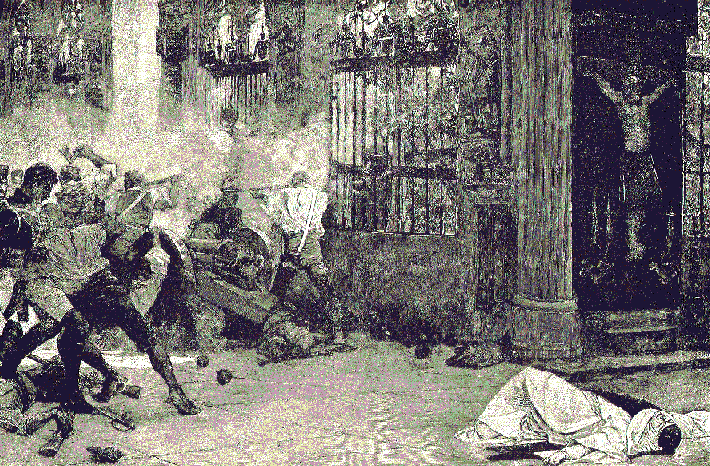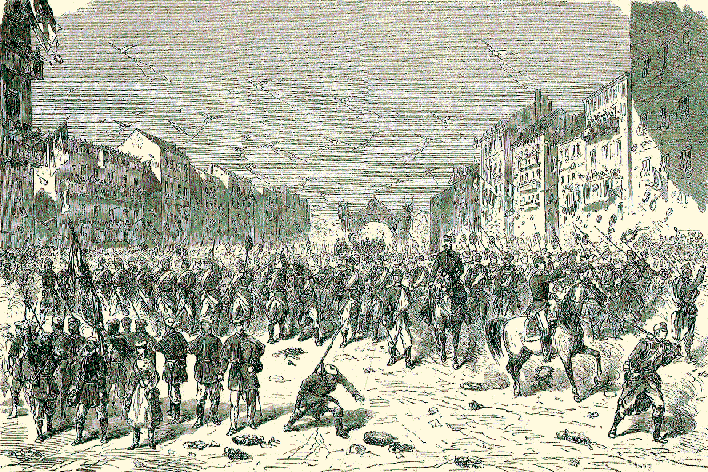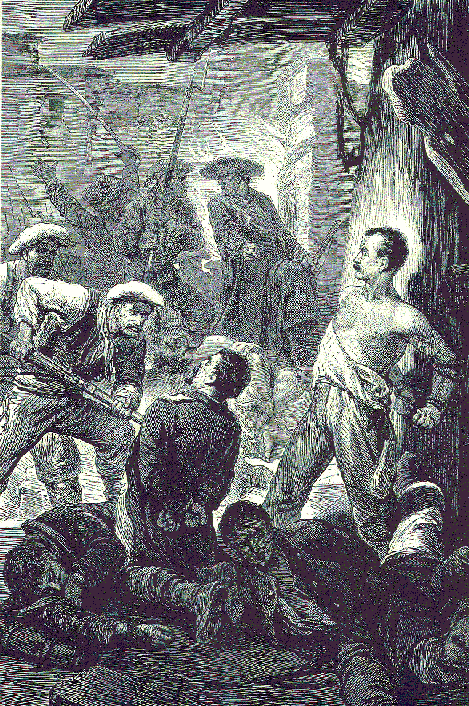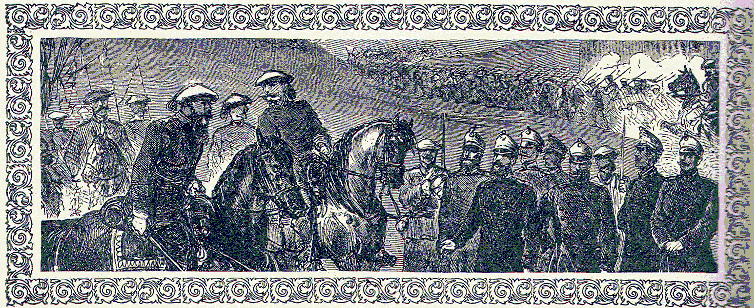Carlist Civil Wars
1836 to 1872
Carlists (traditionalists) — versus — Liberals (Cristinos)
Civil War of 1820 — 1820-1823First Carlist War — 1833-1839
Second Carlist War — 1846-1849Third Carlist War — 1833-1839
 |
To understand the real nature of the conflict one needs to get behind the somewhat misleading "liberal/constitutionalist" and "royalist/traditionalist" labels. The wedge that divided the country had its roots in the Spanish Constitution of 1812, which was promulgated during the Napoleonic Wars, and aimed to radically alter traditional forms of government, customs, taxation, property rights, and economic practices. The ancient systems were unquestionably corrupt, but the constitution did not facilitate the reform of existing institutions, but rather, their wholesale replacement. The stated aims of the constitution were to transfer the power of government from the monarchy into the hands of a legislative body, remove the church and nobility from privileged positions of influence, "set up a rational and efficient centralized administrative system based on reformed and uniform provincial government", and "repeal traditional property restrictions". However, this official sounding statement of purpose fails to communicate the radical and far-reaching changes throughout Spanish society, sought by the Liberals.
Far from being genuinely absolutist, the Spanish monarchy had very limited power to begin with. This was because many regions of the country were locally autonomous, since traditional fueros, granted and respected by the Spanish monarchs, exempted them from taxation and other national laws. It was these fueros, or privileges of local self-rule, that the liberals sought to overturn. Also, almost half the property in Spain was under the control of the Catholic Church, so the Church was wealthier than the government and very influential. The true aims of the liberals were to confiscate church property, tax regional governments, centralize all government power in the hands of the Cortes, and install those sympathetic to their programs in regional governments. Although there was abundant cause for outrage regarding corruption and abuses of clerical and provincial authority, the Liberals program of "reform" was a wholesale transfer of power to themselves. In other words, the essential conflict was about power, money, and economic order rather liberal ideals per se, and it was correspondingly vicious and intractable.
The liberal interests in Spain were strongly backed by wealthy financial interests, the Army, educated city dwellers, the urban merchant class, and imperialist governments in England, Portugal, and France, The conservative, or traditionalist interests were backed by the Catholic Church, the rural districts, the regional nobility, most of the peasant population of the country, and the independent Basque and Navarre provinces in the north. The Bourbon nobility on both sides of the dispute was corrupt and worthless, and the leaders on both sides were self-seeking. In a civil war in which the financial and personal interests of the two sides were so utterly opposed, it was difficult to establish common ground or truly national interests, and even after the liberals succeeded in many of their aims by military means, they found the country practically ungovernable.
Civil War of 1820 : 1820-1823
 |
Ferdinand VII, however, was less a principled royalist than a craven opportunist. The American colonies were in revolt, and he feared that embracing liberal principles would worsen the situation. By 1820, however, the Royalists had suffered severe losses in South America, income from the New World had all but stopped, the treasury was nearly bankrupt, and their was little money to pay the army. These conditions re-invigorated the Liberals, and in 1820 they revolted against Ferdinand and so curtailed his power that he fled to France. A general rising against the Liberals did not occur until 1822, at which time a royalist faction set up an alternate government and a civil war broke out in full. The conflict was vicious and bloody and there were atrocities on both sides.
At this point, the Bourbon government in France decided to intervene on behalf of Ferdinand. A large army was sent over the Pyrenees, and the town of Cadiz, the republican capital, was taken. Ferdinand VII was restored to the throne, and many of the liberal leaders were arrested and executed.
| Date | Battle Summary | |
|---|---|---|
| Battle of Trocadero (Civil War of 1820 )
Royalists victory
Fought August 31, 1823 a French force led by the Duke of Angouleme besieged the fort of Trocadero, defended by 2000 Spaniards on the outskirts of Cadiz. The fort was taken after a bayonet attack, resulting in 400 French and 600 Spanish casualties. As a result, Ferdinand VII was restored to the throne of Spain. | ||
| Bourbon king, restored to the throne of France after the Napoleonic Wars, refused to work with liberal constitution. | |
| Spanish General who fought for the Royalists in South America, and the Liberals in the Spanish Civil War of 1820-23. |
First Carlist War : 1833-1839
 |
The army was strongly behind the Maria Cristina, regent for her daughter Isabella, and the Liberal leader Espartero was a capable general. The early battles went in favor of the Cristinos, as the Liberals called themselves. But the wealthy and powerful Basque region in Northern Spain was strongly royalist, and financed the raising of a substantial army to press the royalist cause. Taxing the prosperous trading regions of the north (who were largely self-governing and exempt from national taxes), confiscating Church property, and centralizing government power were the central aims of the liberals, and all were strongly resisted in the north and the rural districts.
The war was drawn out and particularly vicious. Both sides executed, and sometimes tortured their prisoners. In the cities, monks and religious were taunted and murdered, while in the towns captured by the royalists, liberal adherents abused. The first battles of the war were won by the Cristinos since they had a standing army at-the-ready. The liberals therefore controlled all of the major cities and the institutions of government for the duration of the war. But among the Carlists there arose a terrific general, Tomas Zumalacarregui and he won a series of major victories over the Cristinos from the time he first took up arms in 1833 until his death in 1835. He was particularly successful using a combination of both conventional and guerilla tactics against the Cristinos, and by April of 1845 the Carlists controlled all of the Peninsula north of the Ebro.
The death of Zumalacarregui deprived the Carlists of an effective leader, since Don Carlos, like all the
Bourbon princes, was feeble and craven. Even so, the Carlists were not defeated for over four years,
and probably would not have been, but for the military and financial resources of the British, who
intervened on behalf of the liberals.
A treaty to end hostilities was signed in 1839 by Espartero, who had replaced
Maria Cristina as the regent for Isabella, and Maroto, a Carlist general. Although most of the Carlist
army laid down arms after the treaty was signed, Maroto was considered a traitor by large segments of
the population.
| Date | Battle Summary | |
|---|---|---|
| Siege of Bilbao (First )
Cristinos victory
This fortress was besieged by the Carlists November 9, 1836, and was defended by a small Christino garrison. The besiegers took possession of some of the suburbs, which were recaptured by a sortie. Finally, after several unsuccessful attempts, Espartero, at the head of about 18,000 Christinos, drove off the besiegers, December 25, and relieved the city, capturing the Carlist artillery of 25 pieces. In the action the Christinos lost 714 killed and wounded, while the losses of the garrison during the siege amounted to about 1,300. | ||
| Siege of San Sebastian (First )
Cristinos victory
This fortress, held by a garrison of Cristinos and a small detachment of the British legion, under Colonel Wylde, was besieged by the Carlists, under Sagastibelza, February, 1836. The siege was carried on in desultory fashion, with constant fighting between the outposts, till June, 1836, when General Evans, with 10,000 British and Spanish troops, occupied the advanced Carlist positions, and forced them to withdraw. | ||
| Battle of Hernani (First )
Carlists victory
Fought March 15 and 16, 1837, between the British legion, and a small contingent of Cristinos, under General Evans, and about 17,000 Carlists, under Don Sebastian, strongly posted on the Hernani road. On the 15th, Evans attacked the Carlists on the Venta heights, and after five hours' fighting occupied the position. On the 16th, when the conflict was resumed, the Carlists retired into Hernani, but reinforcements arriving, they took the offensive, and forced Evans to retreat. | ||
| Siege of Irun (First )
Cristinos victory
This fortress was captured, May 18, 1837, by 10,000 Cristinos and British, under General Evans. Evans appeared before the place at noon, and summoned it to surrender. On the Carlists refusing, an assault was ordered; by 1 p.m. the fortress was taken, with very small loss to the assailants. | ||
| Battle of Huesca (First )
Carlists victory
Fought May 23, 1837, between 20,000 Carlists, under Don Carlos and Don Sebastian, and 12,000 Cristinos and British under General Irribarreu. The British legion behaved unsteadily and the Cristinos were driven from the field, though the pursuit was checked by a brilliant cavalry charge, in which Irribarreu fell. The Cristinos lost over 1,000 killed and wounded, of which number the British legion lost 297. | ||
| Battle of Herrera (First )
Carlists victory
Fought August 23, 1837, between the Carlists, under Don Carlos, with General Moreno in actual command, and the Cristinos, under General Buerens. Don Carlos, who was marching upon Madrid, attacked Buerens before he could effect a junction with Espartero, and severely defeated him, the Cristinos losing 50 officers, and 2,600 men killed, wounded and missing. Don Carlos, after this victory, advanced to within twelve miles of Madrid, when the appearance of Espartero, at the head of 20,000 troops, obliged him to retire. | ||
| Battle of Hernani (First )
Carlists victory
Fought August 29, 1836, between the British legion, under General Evans, and the Carlists. Evans was defeated. | ||
| Siege of Pena Cerrada (First )
Cristinos victory
This fortress, held by a Carlist garrison, under Gergue, was captured by Espartero with 19,000 Cristinos, June 21, 1838. After shelling the place for 7 hours, Espartero attacked the Carlists, who held the heights outside the town, and dispersed them, capturing 600 prisoners, and all their guns. The remainder of the garrison then abandoned the place. | ||
| Queen regent of Spain who championed the cause of her daughter Isabella II against the Carlists. | |
| Brother of Ferdinand VII and rival claimant to the Spanish throne who initiated the Carlist Wars. | |
| Courageous and loyal Basque general who commanded the traditionalist troops during the First Carlist War. | |
| Liberal, anti-clerical General who opposed the Carlists, and briefly ruled as regent of Spain before being exiled. | |
| Carlist General who signed the Peace treaty ending the First Carlist War. | |
| Jewish financier who masterminded the liberal economic policies which the Carlists objected to. |
Second Carlist War : 1846-1849
 |
| Date | Battle Summary | |
|---|---|---|
| Siege of Morella (Second )
Cristinos victory
This fortress, the last stronghold of the Carlists, was besieged by Espartero, with 20,000 Cristinos, May 23, 1840. It was defended by a garrison of 4,000 veterans, under Cabrera, who on the 30th attempted to break through the besiegers' lines. His plan, however, had been betrayed, and he was met and driven back, whereupon the place surrendered. Cabrera, however, with a portion of the garrison, made a second and this time a successful attempt to cut his way out. | ||
| 19th century queen of Spain who lived a life of scandal and dissipation and was eventually deposed. | |
| Carlist General in the 2nd Carlist uprising. |
Third Carlist War : 1833-1839
 |
By 1872 virtually all of the characters associated with the first two Carlist Wars were no longer active, and an entire generation had passed in relative peace, since political energy was absorbed in intrigue and infighting rather than military operations. But a series of incidents reignited the Carlist passion. The most important was the appearance on the scene of a young and vigorous conservative leader in the form of Carlos VII, Duke of Madrid, the grandson of Don Carlos. The father of Carlos VII, had never been committed to the Carlist cause and was not trusted by the Conservative factions in Spain, but the young Duke himself was able to excite the old passions. Soon after elections were held and the newly emergent Carlist faction was resisted by the government and prevented from holding political office. It was the combination of an inspiring leader, and frustration an their inability to gain ground by fair democratic means that reignited the Carlist flame.
The Carlists put up a hard fight, and won enough early victories to establish a few strongholds in central, as well as northern Spain. The government forces, however, were larger, better equipped, and continued the press upon the Carlists until the pretender was forced from the country. At the same time, it was agreed that Alfonso XII, the son of Isabel should return from exile and assume the throne. This, to some degree, appeased the conservatives who most ardently opposed a republican government. In February 1876, the Carlists took a final stand at Montejurra and shortly after, Carlos VII left the country.
| Date | Battle Summary | |
|---|---|---|
| Battle of Puente de la Reyna (Third )
Carlists victory
Fought October 6, 1873, between 50,000 Carlists, under Ollo, and about 9,000 Republicans, under Moriones. The Republicans were defeated after hard fighting, and were at last driven in disorder from the field by a bayonet charge. The Carlists lost 113 only; the losses of the Republicans were far heavier. | ||
| Siege of Bilbao (Third )
Republicans victory
This fortress, held by government forces, was besieged by the Carlists between December 1873, and May 1874. When a relieving force, led by Francisco Serrano arrived, they broke the siege and moved on to Estella. | ||
| Battle of Abarzuza (Third )
Carlists victory
In a three day series of battles, the Carlists forces entrenched in their strongholds near Estella forced back a large Republican force under General Concha. The Republicans lost 1000 men before being driven from the region. | ||
| Battle of Montejurra (Third )
Republicans victory
Fought February 17, 1876 between a large Republican army under Fernando Rivera and a defending force of 1600 Carlists under Calderon. The Carlists, who had withstood assaults for over 18 months, were finally forced to withdraw from their stronghold near Estella. | ||
| Carlist Pretender to the throne who played a leading role in the Third Carlist War. | |
| Princes of Savoy who at first accepted the Spanish throne, but then resigned, insisting the nation was 'ungovernable'. | |
| Spanish General and statesman who opposed the Carlists during the third Carlist War. |
| Revolution in | The Romance of Spanish History by John S.C. Abbott |
| The Woman from Naples in | A Child's History of Spain by John Bonner |
| Isabella II in | Story of the Greatest Nations: Spain by Charles F. Horne |
| Elizabeth Farnese and Alberoni in | Historical Tales: Spanish by Charles Morris |
| Hero of the Carlists in | Historical Tales: Spanish by Charles Morris |
| Isabella II and the Carlists in | Spain: A History for Young Readers by Frederick A. Ober |
Image Links | ||
|---|---|---|
 Marshal Prim rallying the Spanish patriots in Story of the Greatest Nations: Spain |
 Marshal Serrano directing his troops at Arcolea in Story of the Greatest Nations: Spain |
 Don Carlos directing his troops in Story of the Greatest Nations: Spain |
 Carlists slaying their republican prisoners at Abazuza in Story of the Greatest Nations: Spain |
 The young king Alfonso XII entering Madrid in Story of the Greatest Nations: Spain |
|